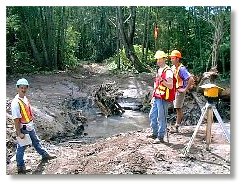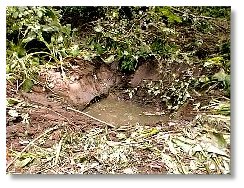My First On Site
Visit
By Damien Barstead
Walking along the newly constructed berm towards Campbellton Elementary, all I
can see is trucks and miscellaneous machines that are restructuring the schoolyard and
surrounding property. Within about 50m of the center of the field, voices from the bush grab my
attention. I skid down the newly placed sod and hike a few meters through the bush into the
active work zone, and am amazed by what I see. The Operations Supervisor, Dan Bernard, and
several other staff are having a discussion amidst a long meandering trench of dirt and clay, with
undamaged skunk cabbage and untouched natural vegetation no farther than 2 meters.away.

Staff stand near a trench of dirt and clay.
Standing in a relatively short section of the channel, I see flat ground above and a v-shaped
ditch below me. From this vantage point I can effortlessly envision the water flowing over the
gravel, into the little pool just in front of me, then splitting around the little island in the center
of the opening and reconnecting in a large pool stocked with large woody debris. How the coho
will love it!
After several discussions with Dan and Jeff (HBKFCS site naturalist), I learn of the goals,
progress and obstacles of the day. The primary goal is to complete as much of the excavation
work as possible in order to minimize the expense of machine and operator rental.
|
However, the excavators seem (to me at least) to have an enormous task to do in
order to make headway. The operators must accurately conform to specifications within an inch
or less. They accomplish this, even with massive shovels swooping through the air. This
accuracy is critical to allow the new waters to flow down the near 0% slope of the land.

A newly dug pool in
Haig-Brown Kingfisher
Creek
Although precision is necessary, I soon realize that flexibility is equally important.
Every situation can be planned on paper, but only with limited realism. Just by walking the site
accompanied by those familiar with it, I realize how spur of the moment decisions, like pulling
large woody debris out of the bush instead of having it shipped in, saves money. Similarly,
deciding to dig around a hemlock tree rather than cut it down, is just another way of being cost
effective while adding to the fish habitat of the stream. When dealing with natural systems and
Mother Nature, this leeway is very important if we are to closely match the original product.
Walking away from the site back to my car, I can't help thinking about how difficult
it will be to communicate my incredible impression of the work site to the readers of this
webzine. It is truly an amazing feat to create productive fish habitat from little more than some
moist mud, skunk cabbage, and trees, but I think that the Haig-Brown Kingfisher Creek Society
is doing it.
Top of page.
|

